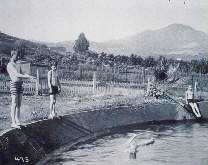the California Waters of Life

Early picture of Isham Springs,
now part of
The Pointe San Diego property
The proprietor, Alfred Huntington Isham, boasted the spa as a "retreat from the hustle and bustle of the city" (turn-of-the-century San Diego) and a "respite from consumption and disease." He also sold the water as a health palliative, constructing a stone spring house and bottling plant at the springhead. At that time, a spur of the National City and Otay Railroad ran from downtown San Diego, through National City, down Sweetwater Valley, stopping in La Presa before terminating near Isham's resort. Families would board the train Sunday mornings after church and travel to Spring Valley to spread a picnic near the springs overlooking the lake and return to the city in the evening. 
One day, Captain Charles Fitzallen, whose clipper ship was berthed in San Diego bay, visited Isham's Springs. The portly, bearded Fitzallen was pre-maturely bald, having sacrificed his mane whilst still a young man. According to the story, Fitzallen bathed in the spring waters, and lo--hair sprang from that bald pate "as soft and fine as a baby's." The entrepreneurial Isham, always seeking a new promotional venture, upped his production of bottled waters, and commenced promoting and shipping them all over the country claiming cures for baldness, halitosis, high blood pressure, cancer and prostrate problems.

Isham enlisted the Prince of Wales as his spokesman--"Now water for the prince will be the same as for the peasant," and strong-armed the three-member San Diego Board of Health to endorse his claims and product.
Isham's resort and the California Waters of Life bottling plant flourished. Flatbeds of bottles left Spring Valley destined for the major metropolises of the East.
ran from downtown San Diego
to Isham's resort.
Isham envisioned more grandiose schemes for "his" valley. He sought to expand his resort to the top of Mt. San Miguel, proposing a celestial resort at the summit, with telescopes and astronomical research equipment to share the heavens with the earthbound common man. His patron in this venture was the widow of famed astronomer Richard Proctor. Isham was forced to abandon his dream, after the groundbreaking Fourth-of-July firework exhibit from the mountaintop, designed to recreate the eruption of Mt. Vesuvius in Italy, was obscured by overcast skies.
The early 1900s were the zenith of the patent medicine era, so Isham found an eager congregation of believers. Ultimately the claims continued to grow in proportion to Isham's ego and imaginination. Finally in 1906, the respected news magazine Collier's ran a series of articles on patent medicine scoundrels, devoting prominent attention on Isham. The resulting exposure and publicity was a fatal blow to the bottling sales and soon after Ishams' water business dried up.
Later Isham's lands were sold to satisfy tax liens to Fred Hansen, who operated a  ranch in Spring Valley, combining raising livestock with dry farming. The two watering tanks built in the 1940s at the site of Isham's Springs were well known in the region as Hansens' Ponds. Although Hansen was a rancher and farmer, he always dreamed of a resort in Spring Valley.
ranch in Spring Valley, combining raising livestock with dry farming. The two watering tanks built in the 1940s at the site of Isham's Springs were well known in the region as Hansens' Ponds. Although Hansen was a rancher and farmer, he always dreamed of a resort in Spring Valley.